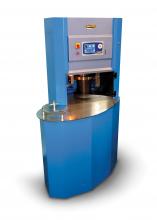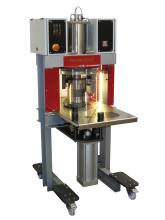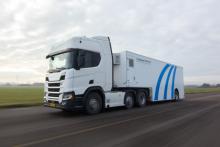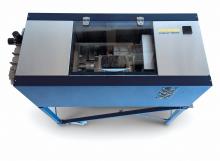A look back at some of the developments this year, and a look ahead to what may come next reveals the increasing use of materials testing. New technology and new ways to process and analyse data will drive change even further - Kristina Smith reports
For materials testing equipment manufacturers, constant change is business as usual. New tests emerge, new standards are written and new practices spread around regions and the world. There are also new materials to deal with: bitumen modified with polymers
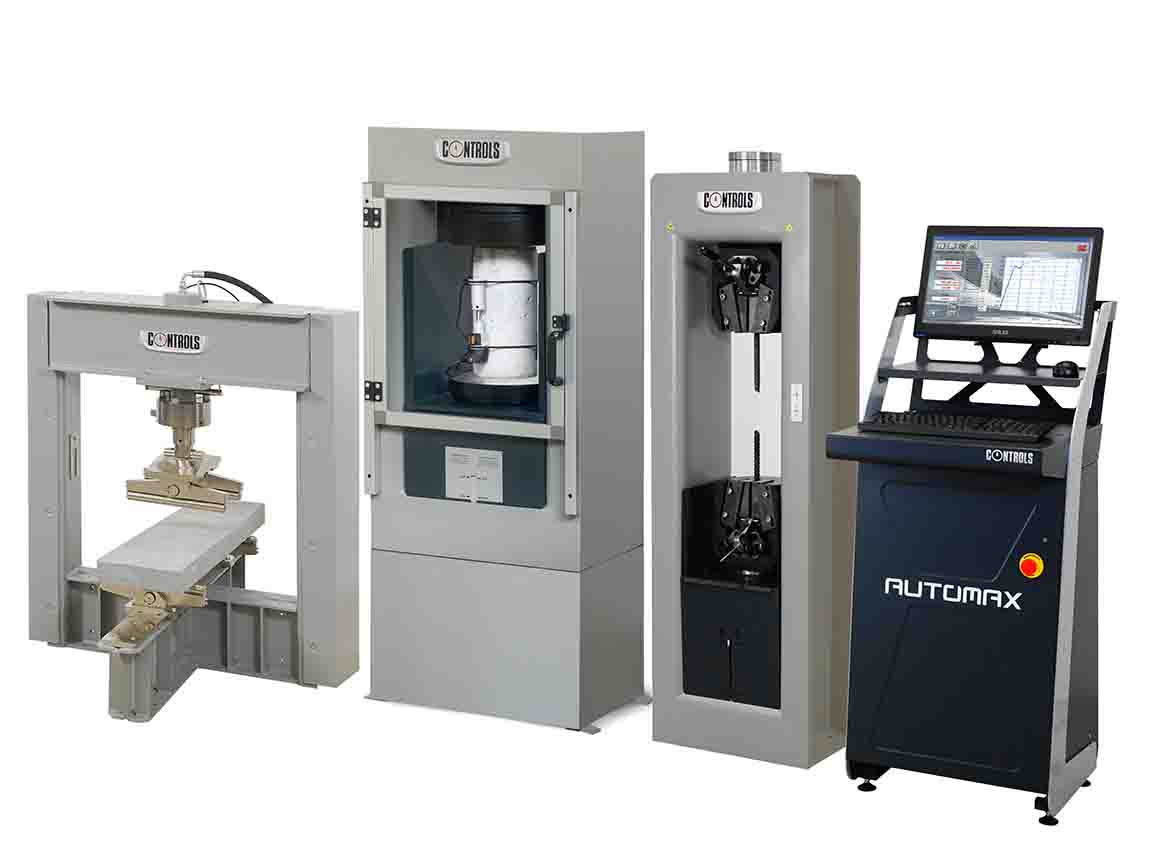
The AUTOMAX control system for universal testing machines (UTMs) offers higher performance
A look back at some of the developments this year, and a look ahead to what may come next reveals the increasing use of materials testing. New technology and new ways to process and analyse data will drive change even further - Kristina Smith reports
For materials testing equipment manufacturers, constant change is business as usual. New tests emerge, new standards are written and new practices spread around regions and the world. There are also new materials to deal with: bitumen modified with polymers or rubber; higher and higher proportions of recycled materials; rejuventators and other additives.
There are other forces for change at work too right now. Tests and testing equipment are no longer the domain of the specialist laboratory. Contractors are using them not just to assure quality but to aid decision-making too. The result is that manufacturers such as2139 CONTROLS are working hard to produce user-friendly and cost-effective machines for a wider range of customers.
The dawning of the digital age is having an impact too. New technologies and leaps forward in the way we can process and analyse information means that real-time testing at the workface has become a reality in some situations. For instance8095 GSSI’s new PaveScan device can map out density as a pavement is laid.
Other examples include Inbye Engineering’s SMUTI (Strength Monitoring Using Thermal Imaging) and Doka’s Concremote system, reported on earlier in the year. SMUTI uses infrared imaging to measure the strength of sprayed concrete within a tunnel, a tool for site engineers and operatives. Concremote uses heat also to predict concrete strength and hence help optimise when shuttering can be struck.
New ways of using information will also mean we can do more with the data we already have. For instance, researchers at Czech Technical University (CTU) in Prague have been investigating how they can use data acquired through laser scanning systems on pavement machines to calculate the smoothness properties of a pavement. They developed software which is able to take and process that existing data and calculate properties such as the International Roughness Index (IRI).
2597 Dynatest has used software and processing to create a whole new application for its FastFWD falling weight deflectometer. And its brand new Rapid Pavement Tester, due to be launched next year, will see its initial uses extended even further thanks to software developments in the future.
“Of our three business units, asphalt is the one that is growing the fastest,” says Andrea Morotti, business development and strategy manager for CONTROLS Group. “And that’s the reason why we are putting such significant investment into this business unit.”
CONTROLS’ ambition, which Morotti says the group has already achieved, is to manufacture a wider range of advanced asphalt and bitumen testing equipment than any of its competitors. “It gives us the chance to be a one-stop supplier,” he says. “For many customers, that’s a key consideration, not just because of the constant commercial relationship but because of the after-sales service.”
CONTROLS Group encompasses soils testing specialist Wykeham Farrance; CONTROLS for concrete testing; and PAVELAB SYSTEMS and3912 IPC Global for binder and asphalt testing. While IPC Global, headquartered in Australia and acquired by Controls in 2014, concentrates on advanced dynamic testing for asphalt mixes, PAVELAB SYSTEMS’ focus is on advanced static testing and binder testing, although there is some crossover between the two divisions.
There have been several developments over the past year in the group’s soil and concrete testing ranges, such as a new automatic triaxial testing machine AUTOTRIAX 2 and the AUTOMAX E-Modulus for determining Elastic Modulus and Poisson’s ratio. However, the asphalt unit has been even busier.
New and improved machines from IPC Global have included the AMPT Pro asphalt mixture performance tester, the second generation of the IPC Global AMPT; an increased range of universal testing machines (UTMs) including the UTM 130 XL for larger specimens; the Autosaw II and multi-core drill for specimen preparation; and a stand-alone semi-circular bend (SCB) tester.
“We have observed the importance of sophisticated dynamic performance-based tests being recognised ever more widely worldwide,” says IPC Global CEO Kieran McGrane. “IPC Global and CONTROLS Group are working hard to provide solutions to ‘democratise’ these important tests: that is producing testing systems that are easy to use, affordable, accurate and reliable.”
PAVELAB SYSTEMS is constantly improving its existing equipment. “One of the advantages of being the designer and manufacturer of our products is that we can listen to our customers and transform their comments into modifications,” says Morotti. Recent improvements have included an enhancement of the slab compactor, now programmable to run energy controlled compaction to draft EN 12697-33 and a research version of the Double Wheel Tracker (DWT) with a higher maximum load and other special functions.
CONTROLS sees a growing demand for machines that can test bitumen. “We have identified bitumen as being an important strategic focus,” says Morotti. “A lot has been done but there will be more new products coming next year.”
This year has seen the launch of the automatic penetrometer, PIVOT, which has a sophisticated system for sensing the initial needle contact; the new Rolling Thin Film Oven Test (RTFOT) with improved user interface and integrated flow meter; and the below-zero ductility meter. The PaveAnalyzer bitumen and binder extractor has been further improved, with tests showing it achieves better accuracy for determining bitumen content compared to traditional methods, according to Morotti.
IPC Global also promises to unveil new equipment in 2017. “We have some exciting developments in the pipeline for release over the next few months,” says McGrane.
One way to speed up the acceptance process might be to use a test track such as the National Centre for Asphalt Technology’s (NCAT’s) facility in Auburn, US. Another could be to employ mobile testing equipment such as a heavy vehicle simulator (HVS) to achieve accelerated pavement testing on sections of road.
The method used by2597 Dynatest at Rome’s Fiumicino airport. The airport’s runway 3 was in need of rehabilitation; founded on peat, the pavement was continually settling, with more asphalt added to restore the runway's level, further adding to the weight and the settlement problem.
The proposed solution was to make the weight of the combined pavement construction equivalent to the weight of the peat soil it was replacing. This required some form of lightweight aggregate below the asphalt, with engineers eventually deciding on a new material made from recycled glass foam.
In order to confirm the performance of this new pavement design, Dynatest - which provides consultancy services as well as manufacturing tesing equipment - made an inventive use of its FastFWD (falling weight deflectometer) which it launched in 2015. The FastFWD was originally developed to improve the speed of testing, collecting points at a rate five times faster than previous FWDs. It also requires less maintenance than its predecessor as it has no hydraulics.
Dynatest discovered that by repeatedly dropping the weight from the FastFWD onto a section of pavement, it could simulate the load applied during that pavement’s life. One big advantage of the FastFWD over the HVS is that it costs around twenty times less.
“Rather than using the FastFWD for its standard purpose of measuring bearing capacity, we are using it for accelerated pavement testing to see how the pavement is deteriorating under load application and traffic conditions,” says Alessandro Marradi, a senior consulting engineer for Dynatest and assistant professor at the University of Pisa.
At Fiumicino airport, where the FastFWD was simulating planes landing, Dynatest was able to demonstrate that the maximum stress experienced by the unbound glass material was 56KPa and that there was no settlement until stress levels reached 120KPa.
The tests were carried out in August 2015 and the runway pavement remains intact. Dynatest is now planning further tests on different lightweight materials for the airport, to help inform plans to add further runways and terminal buildings which could also be founded on poor ground.
Initially, Dynatest is only using the FastFWD for accelerated pavement testing internally as part of its consultancy services. Once it has assured the FastFWD’s durability and robustness in the new role, the company plans to market the machine as an accelerated pavement tester.
Next year will also see the fruition of five years of R&D when Dynatest starts to use its Rapid Pavement Tester, nicknamed the RAPTOR.
“Its purpose is to characterise the bearing capacity of a stretch of road,” explains Dynatest R&D manager Jack Larsen. “The equipment will function as a screening tool so you can quickly drive through a large network of roads and get an overview of the bearing capacity of the roads which then allows you to focus attention on the areas that need further investigation or repairs.”
The RAPTOR is mounted on a trailer behind a truck with sensors mounted on a long, stiff beam which measure the distance from the beam to the road so that the deflection of the road can be calculated. “Each of our laser-based sensors has a built-in camera, which acquires images of the laser line from an angle, so that we can generate a height map of the pavement,” explains Larsen. “By correlating height maps generated from several sensors using our software, it is possible to determine the deflection basin at the rear wheels of the vehicle.”
In contrast to the FWD, the RAPTOR does not need to stop to do its measurements, requiring road closures or traffic management. Instead, it can measure at normal traffic speed which means it can be used to assess whole road networks to find weak spots, rather than for limited lengths of road.
The function of the Raptor is similar to earlier generation units which measure the velocity of displacement or the road and then converts that to a distance. One benefit of the Raptor is that its sensors cost 10% of those in earlier generation equipment. Larsen says that the Raptor is easier to calibrate than previous units.
The development of the RAPTOR to date, which has received funding from the Danish Innovation Fund, represents Dynatest’s biggest ever research project with a price tag of nearly 40 million Danish Kroner. Initially Dynatest plans to use the RAPTOR to supply services through its consultancy division from 2018, rather than to sell the equipment itself.
Further developments of processing and software could broaden the uses of the RAPTOR. “The dream in the long run is to make it more sophisticated and do the measurements even more precisely,” says Larsen. “We not only need to improve the precision of the sensors, we also need to develop new analysis tools in order to analyse the data.”
8095 GSSI has launched PaveScan RDM which measures the density of asphalt in real time.
PaveScan promises a faster and safer system of measurement than existing methods for measuring density: either taking core samples, which is both destructive and disruptive, or using nuclear density testing which requires sections of road to be cordoned off and involves specific safety procedures.
Ground penetrating radar (GPR) measures density by correlating dielectric measurements with the percentage of air voids in the new pavement. Research in Finland in the 1990s first showed that this method was possible, with subsequent studies in the US developing the technology further.
PaveScan can simply be driven over sections of pavement, mounted on a trailer or a vehicle. It comes with a customised Panasonic tough book and concentrator box and, according to GSSI, can be easily integrated with GPS systems.
The density of a pavement is important because it indicates how well the asphalt has been compacted. Poorly compacted asphalt can lead to problems such as premature oxidation ageing, increased cracking, rutting, structure weakening, ravelling and stripping. Testing density at the time of laying allows for any weak spots to be identified so that remedial action can take place.
Another benefit of using GPR, rather than coring or nuclear gauges, is that it allows contractors and owners to better understand how the paving process affects the density and hence the potential durability of stretches of pavement. Equipment such as PaveScan can create a map which can indicate joins in paving, different batches of asphalt and changes in compaction processes or equipment.
For materials testing equipment manufacturers, constant change is business as usual. New tests emerge, new standards are written and new practices spread around regions and the world. There are also new materials to deal with: bitumen modified with polymers or rubber; higher and higher proportions of recycled materials; rejuventators and other additives.
There are other forces for change at work too right now. Tests and testing equipment are no longer the domain of the specialist laboratory. Contractors are using them not just to assure quality but to aid decision-making too. The result is that manufacturers such as
The dawning of the digital age is having an impact too. New technologies and leaps forward in the way we can process and analyse information means that real-time testing at the workface has become a reality in some situations. For instance
Other examples include Inbye Engineering’s SMUTI (Strength Monitoring Using Thermal Imaging) and Doka’s Concremote system, reported on earlier in the year. SMUTI uses infrared imaging to measure the strength of sprayed concrete within a tunnel, a tool for site engineers and operatives. Concremote uses heat also to predict concrete strength and hence help optimise when shuttering can be struck.
New ways of using information will also mean we can do more with the data we already have. For instance, researchers at Czech Technical University (CTU) in Prague have been investigating how they can use data acquired through laser scanning systems on pavement machines to calculate the smoothness properties of a pavement. They developed software which is able to take and process that existing data and calculate properties such as the International Roughness Index (IRI).
CONTROLS Group
Expecting further demand in testing equipment for asphalt mixes and binders, CONTROLS Group has been working on the development of new and existing machines.“Of our three business units, asphalt is the one that is growing the fastest,” says Andrea Morotti, business development and strategy manager for CONTROLS Group. “And that’s the reason why we are putting such significant investment into this business unit.”
CONTROLS’ ambition, which Morotti says the group has already achieved, is to manufacture a wider range of advanced asphalt and bitumen testing equipment than any of its competitors. “It gives us the chance to be a one-stop supplier,” he says. “For many customers, that’s a key consideration, not just because of the constant commercial relationship but because of the after-sales service.”
CONTROLS Group encompasses soils testing specialist Wykeham Farrance; CONTROLS for concrete testing; and PAVELAB SYSTEMS and
There have been several developments over the past year in the group’s soil and concrete testing ranges, such as a new automatic triaxial testing machine AUTOTRIAX 2 and the AUTOMAX E-Modulus for determining Elastic Modulus and Poisson’s ratio. However, the asphalt unit has been even busier.
New and improved machines from IPC Global have included the AMPT Pro asphalt mixture performance tester, the second generation of the IPC Global AMPT; an increased range of universal testing machines (UTMs) including the UTM 130 XL for larger specimens; the Autosaw II and multi-core drill for specimen preparation; and a stand-alone semi-circular bend (SCB) tester.
“We have observed the importance of sophisticated dynamic performance-based tests being recognised ever more widely worldwide,” says IPC Global CEO Kieran McGrane. “IPC Global and CONTROLS Group are working hard to provide solutions to ‘democratise’ these important tests: that is producing testing systems that are easy to use, affordable, accurate and reliable.”
PAVELAB SYSTEMS is constantly improving its existing equipment. “One of the advantages of being the designer and manufacturer of our products is that we can listen to our customers and transform their comments into modifications,” says Morotti. Recent improvements have included an enhancement of the slab compactor, now programmable to run energy controlled compaction to draft EN 12697-33 and a research version of the Double Wheel Tracker (DWT) with a higher maximum load and other special functions.
CONTROLS sees a growing demand for machines that can test bitumen. “We have identified bitumen as being an important strategic focus,” says Morotti. “A lot has been done but there will be more new products coming next year.”
This year has seen the launch of the automatic penetrometer, PIVOT, which has a sophisticated system for sensing the initial needle contact; the new Rolling Thin Film Oven Test (RTFOT) with improved user interface and integrated flow meter; and the below-zero ductility meter. The PaveAnalyzer bitumen and binder extractor has been further improved, with tests showing it achieves better accuracy for determining bitumen content compared to traditional methods, according to Morotti.
IPC Global also promises to unveil new equipment in 2017. “We have some exciting developments in the pipeline for release over the next few months,” says McGrane.
Dynatest
One of the barriers to innovation in paving design and construction is the need for trials. Owners must assure themselves that new materials and systems perform in the field as predicted by tests in the laboratory and the designers’ models.One way to speed up the acceptance process might be to use a test track such as the National Centre for Asphalt Technology’s (NCAT’s) facility in Auburn, US. Another could be to employ mobile testing equipment such as a heavy vehicle simulator (HVS) to achieve accelerated pavement testing on sections of road.
The method used by
The proposed solution was to make the weight of the combined pavement construction equivalent to the weight of the peat soil it was replacing. This required some form of lightweight aggregate below the asphalt, with engineers eventually deciding on a new material made from recycled glass foam.
In order to confirm the performance of this new pavement design, Dynatest - which provides consultancy services as well as manufacturing tesing equipment - made an inventive use of its FastFWD (falling weight deflectometer) which it launched in 2015. The FastFWD was originally developed to improve the speed of testing, collecting points at a rate five times faster than previous FWDs. It also requires less maintenance than its predecessor as it has no hydraulics.
Dynatest discovered that by repeatedly dropping the weight from the FastFWD onto a section of pavement, it could simulate the load applied during that pavement’s life. One big advantage of the FastFWD over the HVS is that it costs around twenty times less.
“Rather than using the FastFWD for its standard purpose of measuring bearing capacity, we are using it for accelerated pavement testing to see how the pavement is deteriorating under load application and traffic conditions,” says Alessandro Marradi, a senior consulting engineer for Dynatest and assistant professor at the University of Pisa.
At Fiumicino airport, where the FastFWD was simulating planes landing, Dynatest was able to demonstrate that the maximum stress experienced by the unbound glass material was 56KPa and that there was no settlement until stress levels reached 120KPa.
The tests were carried out in August 2015 and the runway pavement remains intact. Dynatest is now planning further tests on different lightweight materials for the airport, to help inform plans to add further runways and terminal buildings which could also be founded on poor ground.
Initially, Dynatest is only using the FastFWD for accelerated pavement testing internally as part of its consultancy services. Once it has assured the FastFWD’s durability and robustness in the new role, the company plans to market the machine as an accelerated pavement tester.
Next year will also see the fruition of five years of R&D when Dynatest starts to use its Rapid Pavement Tester, nicknamed the RAPTOR.
“Its purpose is to characterise the bearing capacity of a stretch of road,” explains Dynatest R&D manager Jack Larsen. “The equipment will function as a screening tool so you can quickly drive through a large network of roads and get an overview of the bearing capacity of the roads which then allows you to focus attention on the areas that need further investigation or repairs.”
The RAPTOR is mounted on a trailer behind a truck with sensors mounted on a long, stiff beam which measure the distance from the beam to the road so that the deflection of the road can be calculated. “Each of our laser-based sensors has a built-in camera, which acquires images of the laser line from an angle, so that we can generate a height map of the pavement,” explains Larsen. “By correlating height maps generated from several sensors using our software, it is possible to determine the deflection basin at the rear wheels of the vehicle.”
In contrast to the FWD, the RAPTOR does not need to stop to do its measurements, requiring road closures or traffic management. Instead, it can measure at normal traffic speed which means it can be used to assess whole road networks to find weak spots, rather than for limited lengths of road.
The function of the Raptor is similar to earlier generation units which measure the velocity of displacement or the road and then converts that to a distance. One benefit of the Raptor is that its sensors cost 10% of those in earlier generation equipment. Larsen says that the Raptor is easier to calibrate than previous units.
The development of the RAPTOR to date, which has received funding from the Danish Innovation Fund, represents Dynatest’s biggest ever research project with a price tag of nearly 40 million Danish Kroner. Initially Dynatest plans to use the RAPTOR to supply services through its consultancy division from 2018, rather than to sell the equipment itself.
Further developments of processing and software could broaden the uses of the RAPTOR. “The dream in the long run is to make it more sophisticated and do the measurements even more precisely,” says Larsen. “We not only need to improve the precision of the sensors, we also need to develop new analysis tools in order to analyse the data.”
GSSI
Ground penetrating radar specialistPaveScan promises a faster and safer system of measurement than existing methods for measuring density: either taking core samples, which is both destructive and disruptive, or using nuclear density testing which requires sections of road to be cordoned off and involves specific safety procedures.
Ground penetrating radar (GPR) measures density by correlating dielectric measurements with the percentage of air voids in the new pavement. Research in Finland in the 1990s first showed that this method was possible, with subsequent studies in the US developing the technology further.
PaveScan can simply be driven over sections of pavement, mounted on a trailer or a vehicle. It comes with a customised Panasonic tough book and concentrator box and, according to GSSI, can be easily integrated with GPS systems.
The density of a pavement is important because it indicates how well the asphalt has been compacted. Poorly compacted asphalt can lead to problems such as premature oxidation ageing, increased cracking, rutting, structure weakening, ravelling and stripping. Testing density at the time of laying allows for any weak spots to be identified so that remedial action can take place.
Another benefit of using GPR, rather than coring or nuclear gauges, is that it allows contractors and owners to better understand how the paving process affects the density and hence the potential durability of stretches of pavement. Equipment such as PaveScan can create a map which can indicate joins in paving, different batches of asphalt and changes in compaction processes or equipment.

